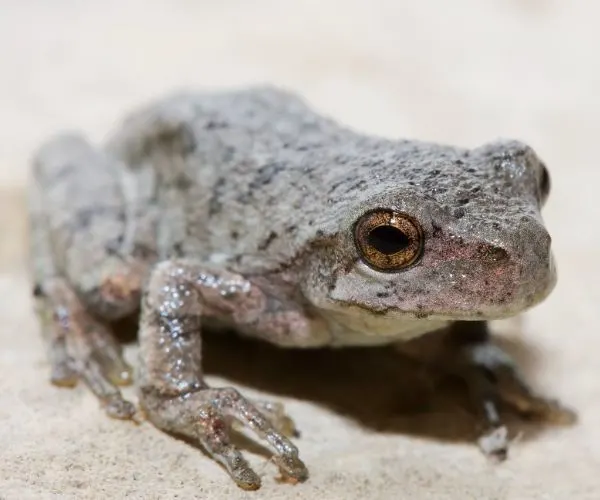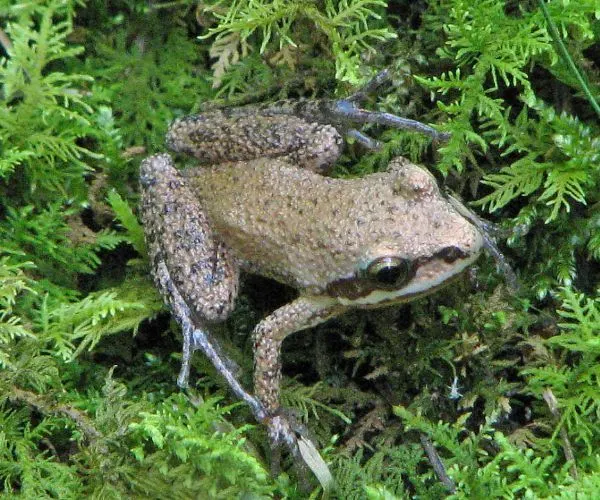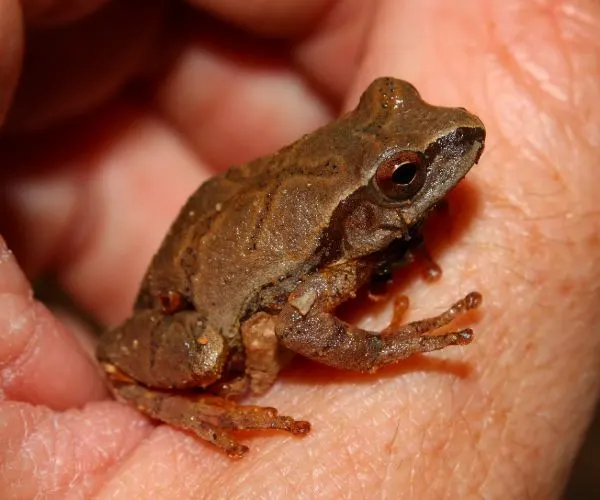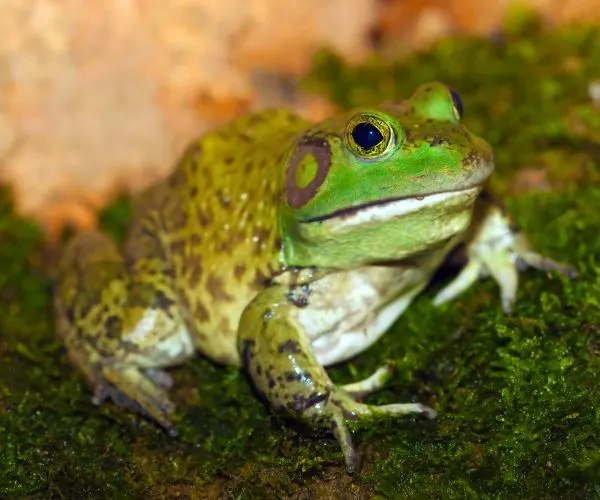There are 15 different species of frog in Ohio. Many of them live near water sources in the state. Forests. Prairies, swamps, and woodlands are common habitats these frogs live in.
Frogs have been known to adapt well to humans and use natural man-made water sources to breed. Swimming pools can sometimes be filled with tadpoles after a frog decides to lay their eggs in one.
All of the species on this list are harmless and only some will irritate human skin. Frogs are helpful in killing insects and keeping a natural balance of animals in the wild. Many of the species have a healthy population, but some are in decline.
Contamination of water sources and a lack of resources have contributed to their lowering of population.
On this list, you will find all of the species of frogs in Ohio from toads to tree frogs. When out in the wild some frogs will be hiding since they are shy or nocturnal. Looking in the right places is essential to finding and appreciating these creatures. This list will help you be able to identify the habitats and species that live in Ohio.
Table of Contents
Frogs in Ohio
1. Eastern Spadefoot Toad

- Experience Level: Beginner
- Family: Pelobatidae
- Scientific Name: Scaphiopus holbrookii
- Other Names: The spadefoot toad
- Adult Size: 1 ¾- 2 ¼ inches
- Lifespan: 2-10 years
- Average Price Range: $10-$20
The Eastern Spade toad can be found in Ohio and is one of the only frog species that are endangered. The flood plains’ habitat is where you will most likely find this species. They enjoy soft sandy soil near wet areas. These frogs are a burrowing species, emerging on warm summer nights.
Eastern spade toads are small, about 1 inch. On their back is a round gland and small warts sit on their skin. Spadefoots are brown, with a yellow hourglass pattern on their back. Their eyes are large and elliptical.
This toad spends a long time underground and will come out in heavy rainfall to mate. Males make a “cawing” noise when trying to attract a female. They will also emerge to hunt small insects like spiders.
The spadefoot toad’s secretive lifestyle makes it hard for experts to examine them in the wild. Many people think this frog smells like peanut butter when picked up.
2. Eastern American Toad

- Experience Level: Beginner
- Family: Bufonidae
- Scientific Name: Anaxyrus americanus
- Other Names: American Toad
- Adult Size: 2-3 ½ inches
- Lifespan: 2-10 years
- Average Price Range: $20-$30
The American Toad lives all throughout Ohio and enjoys living in moist areas. This frog can live in most places, even residential areas. This is one of the most widespread toads, being found in every county in Ohio. A water source for breeding is the only requirement for their living spaces.
Marshes, rivers, swamps, and streams create the ideal breeding habitat. This toad is nocturnal and in the warm months of summer, it will hide under rocks and other natural debris.
These toads have a classic toad look to them. They have a variety of base colors and can be brown, yellow, olive, gray red, and black. Its skin is dry and covered in warts. Its belly and chest are a light cream color with molting marks.
March is when this species comes out of hibernation. After hibernation, till May this species mating call can be heard. American toads only eat insects and can eat as many as 3,000 a month to survive. Surprisingly this animal does not drink water but absorbs it through its skin.
3. Fowler’s Toad

- Experience Level: Beginner
- Family: Bufonidae
- Scientific Name: Anaxyrus fowleri
- Other Names: Bufo fowleri
- Adult Size: 2-3 inches
- Lifespan: 2-10 years
- Average Price Range: $10-$20
Fowler’s toads can be found in the U.S and inhabit most counties in Ohio, only being absent from a few. Open fields and valleys, with water, are where this toad is generally found.
They prefer sandy soil and can even be found in agricultural areas. This species has a strong population but is not as commonly found as the American Toad.
Brown, tan, gray, and light green are colors found in this species. Dark spots cover its back, sides, legs, and into its groin. Yellow markings can occur on its body, and it has a light-colored stripe running down its back.
This toad is covered with warts, which are small and grainy, and has at least three warts a spot. It has a white underside and a dark mark covering its chest.
Like most toads, this species survives off insects like worms, slugs, and spiders. Mating begins from May into June. During this time a low nasally sheep-like call can be heard, calling to other frogs for mating. When in danger this species will burrow, play dead, or flee.
4. Blanchard’s Cricket Frog

- Experience Level: Beginner-Intermediate
- Family: Hylidae
- Scientific Name: Acris crepitans blanchardi
- Other Names: N/A
- Adult Size: ⅝ – 1 ½ inches
- Lifespan: 1 year
- Average Price Range: N/A
The Blanchards Cricket frog can be found in the western half of Ohio and is more common in the Southwestern area. This species has been on a rapid decline and in some areas considered endangered.
Habitat loss, chemical pollution, and lack of resources have all contributed to this frog’s decline. Along creeks, rivers and other water sources with lots of sun make for a perfect habitat for this frog.
This frog is brown, gray, or olive-colored with a white belly. Warts cover its back, along with some black spots and red or green markings. Dark lines appear on its back and legs. Its upper jaw extends beyond the lower jaw when viewed from the side.
From April until July, you can hear the call of this frog, which is a clicking sound that lasts for about 7 seconds. These frogs are active from spring to fall. They will find an animal burrow like a crayfish home to take shelter in the winter. This species can tolerate being frozen for more than 24 hours.
5. Cope’s Gray Treefrog

- Experience Level: Beginner
- Family: Hylidae
- Scientific Name: Hyla chrysoscelis
- Other Names: N/A
- Adult Size: 1 ¼ inch
- Lifespan: 7-10 years
- Average Price Range: $20
Cope’s Gray Tree Frogs live all across Ohio. They inhabit woodlands and forest habitats. Swamp Forests are their preferred habitat but can be found in less wet areas. It is common to find them out in open grasslands traveling to a breeding pool.
This species is usually gray but can turn into a bright green. Bright yellow patches appear on the inside of their hind legs, which can help identify them from other tree frogs.
Males have a darker black throat compared to females. Their skin is bumpy and they have thin black markings on their back. If frightened they will try to hide under debris or fall. This frog is very similar to the regular gray treefrog but has a slightly different croak.
6. Gray Treefrog

- Experience Level: Beginner
- Family: Hylidae
- Scientific Name: Hyla versicolor
- Other Names: N/A
- Adult Size: 1 ¼ inches
- Lifespan: 7-10 years
- Average Price Range: $20
The gray tree frog can be found in the northern two-thirds of Ohio. Habitats with lots of trees and shrubs are places they live in. They spend most of their time climbing in vegetation.
These frogs are nocturnal and can be heard in some residential areas croaking. Climbing in high trees is a common pastime, but they will travel to ponds, marshes, and man-made water sources to mate. They will not likely lay eggs in permanent water due to fish and other predators.
This frog changes its color to match its environment and what it is doing. It can be gray or brown and they have a blotchy pattern on the upper half of their body.
White spots sit underneath each eye and they have a line that stretches from their eyes to legs. Their snout is blunt and their skin is covered in warts.
Gray treefrogs will pray on many different kinds of insects like snails, plant lice, and slugs. Smaller frogs are sometimes a part of their diet. When inactive they will hide in tree holes, under logs, and other natural debris.
7. Mountain Chorus Frog

- Experience Level: Intermediate
- Family: Hylidae
- Scientific Name: Pseudacris brachyphona
- Other Names: N/A
- Adult Size: 1-1 ¼ inch
- Lifespan: 1-3 years
- Average Price Range: N/A
The Mountain chorus frog lives in wooded hillsides with springs and other water sources. This frog is only found in a small part of Ohio and will generally live in high elevation areas with shallow bodies of water.
This species is secretive so little is known about it, but its population has been seen to decline. In the day and night, these frogs will be active. When breeding occurs, males will call from wide-open areas. In the summer months, adults are rarely seen.
This frog is gray to olive and has a dorsal pattern that looks similar to reversed parentheses. Males have dark throats and on both genders is a yellow coloring between their legs. This species has a stockier body, bigger head, and large pads on its feet, unlike other chorus frogs.
Ants, beetles, flies, centipede,s, and other insects are its primary direct. Bullfrogs will often prey upon and consume this species of frog. Its call has been told to sound like a finger running through a comb.
8. Northern Spring Peeper

- Experience Level: Intermediate
- Family: Hylidae
- Scientific Name: Pseudacris crucifer crucifer
- Other Names: Spring peeper
- Adult Size: ¾ – 1 ¼ inch
- Lifespan: 2-4 years
- Average Price Range: $10-$20
Northern Spring Peeper frogs live in most Ohio counties and inhabit the swamps and wet woodlands habitat. They are great climbers due to the pads on their feet but will spend most of their time on the ground.
This species is known for its whistling mate call, which can be very loud. Mating occurs in late February and goes into the end of May. It will hibernate under logs and lose bark when winter comes.
Northern Spring Peeper frogs are small tree frogs with smooth skin. They can be brown, tan, gray with light-colored white bellies.
Coloring to match tree bark will help them camouflage, and they can change their shade to make themselves blend in better. Their back has white lines that create an X-shaped pattern and they have dark coloring on their legs and near their eyes.
This frog is nocturnal and enjoys spending time in trees and shrubs. Spiders, beetles, ants, and small invertebrates are what it hunts. This is one of the most popular frogs in Ohio, besides the Bullfrog.
9. Western Chorus Frog

- Experience Level: Intermediate
- Family: Hylidae
- Scientific Name: Pseudacris triseriata
- Other Names: striped chorus frog
- Adult Size: ¾ 1 ½
- Lifespan: 1-4 years
- Average Price Range: N/A
Western Chorus frogs can be found in most of Ohio and will live near a water source. Permanent water sources can be used by these frogs, but they prefer short-term water habitats to protect their eggs. Swamps, marshes, wet fields, and edges of ponds are where they typically breed. Large vegetation and thick grass is a common trait in any habitat they live in. This frog is nocturnal and is most active on warm summer nights. Males and females will often croak together and create a chorus.
These frogs are small and smooth. They can be greenish-gray, reddish, brown, or olive in color. Brown circular-shaped stirpes run down its back, which looks similar to blotches. More brown stirpes run from the mouth to the sides of this frog.
Small invertebrates are what this species survives on. They are a secretive species and will stop croaking and dive into the water if disturbed. This species has a healthy population, but in some areas is declining.
10. American Bullfrog

- Experience Level: Intermediate-Advanced
- Family: Ranidae
- Scientific Name: Rana catesbeiana
- Other Names: lithobates catesbeianus
- Adult Size: 3 ½ -6 inches
- Lifespan: 7-15 years
- Average Price Range: $20
American Bullfrogs live in habitats with permanent bodies of water. Swamps, lakes, and ponds are common places to find this species in Ohio.
They can take advantage of man-made waters sources like canals or culverts to live in. Bullfrogs come out of hibernation in April and will be active until October. This species is nocturnal and will shout its “jug-o-rum” sounding call in spring to mate.
The Bullfrog is the largest species of frog in North America and Ohio. It is yellow to green and covered in dark coloring. They have fat lips, big bodies, and large eyes.
Males are smaller than females and have yellow throats. Its front legs ar short and its back legs are large.
Bullfrogs have a wide diet and will eat many things in their habitat. Mice, frogs, insects, and even snakes are some of the things they prey on.
This frog is harder to keep as a pet since it requires such a large habitat. Bullfrogs are hunted in some areas so their legs can be cooked and served.
11. Northern Green Frog

- Experience Level: Beginner
- Family: Ranidae
- Scientific Name: Lithobates clamitans melanota
- Other Names: Rana clamitans melanota
- Adult Size: 2 ¼ – 3 ½ inches
- Lifespan: 10 years
- Average Price Range: $10-$15
Northern Green Frogs live in marshes, swamps, lakes, and other kinds of water habitats. This species lives all throughout Ohio and near its natural water sources. Breeding occurs at the begging of May and ends in August. Male frogs make a “gungk” noise to attract a mate.
The color of this frog can be brown, green, or greenish-brown. Its belly is white and molting can appear on its side. It has a dorsolateral fold on its side and a circle mark on its cheek. Their vocal sack is inside their mouths.
These frogs are kept as common pets and can live up to ten years if properly taken off. Crickets, nightcrawlers, and mealworms easily accessible food that they enjoy. In the wild, they eat any bugs they can find like spiders, ants, or slugs.
12. Pickerel Frog

- Experience Level: Intermediate
- Family: Ranidae
- Scientific Name: Lithobates palustris
- Other Names: Rana palustris
- Adult Size: 1 ¾ – 3 inches
- Lifespan: 5-8 years
- Average Price Range: $10-$15
Pickerel Frogs can be found in the Eastern half of Ohio and may also live in the Northwest parts of the state. Streams, ponds, lakes, and slow-moving water sources are great habitats for this frog. Wet areas with high sources of vegetation and woodlands are areas this species thrives in.
Pickerel Frogs can be olive green, tan, or brown with a white stomach. On the sides of their belly is yellow or orange coloring. Brown spots cover its back, legs, and sides.
This frog has a very similar appearance to the leopard frogs, but there are some slight differences. A shorter more blunt stout, square spots, and the orange coloring will help you differentiate the two.
As a tadpole they eat algae but as they mature they survive invertebrates and insects. The bright orange coloring between their legs will be flashed at a predator to confuse them. Pickerel Frogs produce a toxin in their skin that can irritate humans and kill smaller animals.
This makes snakes and other predators hesitant to eat this frog. In March to early May is when mating occurs, which can result in as much as 3,000 eggs.
13. Northern Leopard Frog

- Experience Level: Beginner
- Family: Ranidae
- Scientific Name: Lithobates pipiens
- Other Names: Rana pipiens
- Adult Size: 2 – 3 ½ inches
- Lifespan: 2-4 years
- Average Price Range: $10-$15
Northern Leopard Frogs are found all throughout Ohio and have a healthy population. These frogs are also known as the “grass frog” since they are found in meadows and fields.
When breeding they will go near water sources like shallow ponds, swamps, or marshes to find a mate. These frogs are active mostly at night.
Green and brown are the most common colors of this species, but they can also be light tan. Dark spots cover its back and sides, but unlike the southern leopard frog, these spots have a light border surrounding them.
Some frogs will lack the spots on their back but will have them on their legs. Two dorsolateral folds appear going from both eyes to the back of their legs.
If scared this frog will hop in a zig-zag pattern to escape. They survive on worms, spiders, and other small insects. March to May is when this species begins to breeds.
They use a mating call which can be done even underwater. October is when they begin to hibernate and find a pond to rest in.
14. Southern Leopard Frog

- Experience Level: Beginner
- Family: Ranidae
- Scientific Name: Lithobates sphenocephalus
- Other Names: Rana sphenocephalus
- Adult Size: 2- 3 ½ inches
- Lifespan: 2-4 years
- Average Price Range: $10-$15
Southern Leopard Frogs have been seen to have a small population in South Central Ohio and can be found in fields, meadows, woodlands, and near water. These frogs are active day and night. Rain will cause them to be more active than usual and breed.
These frogs are medium-sized, about 2-3inches long. They are dark brown or green and have a pale yellow belly. Dark-colored spots cover its legs, back, and sides. A yellow stripe runs down both sides and back of the frog.
Southern Leopard Frogs are active at night but will sometimes appear during the daytime and in heavy rain. They breed in spring and winter. Males make a loud chuckling croak sound when trying to attract a female. These frogs survive off crayfish and small insects they can find.
15. Wood Frog

- Experience Level: Beginner
- Family: Ranidae
- Scientific Name: Lithobates sylvaticus
- Other Names: Rana sylvaticus
- Adult Size: 1 ⅜ – 2 ¾ inches
- Lifespan: 1-3 years
- Average Price Range: $15-$30
Wood Frogs can be found all across Ohio in deep woodlands with wet soil. These frogs spend most of their time on land, even hibernating on it. During summer they dwell in forests, ravines, swamps and marshes.
In winter they hibernate near pools or ponds and are one of the first frog species to become active. These frogs are valued in the scientific community for their ability to survive in freezing temperatures.
Wood frogs’ base color is brown, but it can sometimes be reddish. They have no markings usually but can have small dots spread across their back. Under their eyes is a dark brown mark that goes to their nose.
Fast speed and long jumps help the Wood frog catch small invertebrates. If frightened they will flee and try to hide under leaf litter or other debris. This species is abundant and has a healthy population in Ohio.
Wrapping up
The 15 frogs that live in Ohio can be very similar to each other, but each can be identified by some specific traits. Color, size, and location can help you differentiate one frog’s species from the next.
Tree frogs can be found mostly in the trees while others prefer more wet habitats. Each frog will have its own habitat it prefers, but all will go to a body of water to mate. Their different calls can be heard and used to identify what species is near you.
Frogs can make great pets if properly taken care of. Each species has its own needs so it is best to research what frog is best for you. Some frogs can even be kept outside near a backyard pond, instead of a container. Frogs are unique and make great companions.
Ohio has many frog species that are abundant within the state, Tadpoles are also common to see in many lakes and man-made water sources. This list will help you next time you come across one of these amazing creatures.
Nearby states
